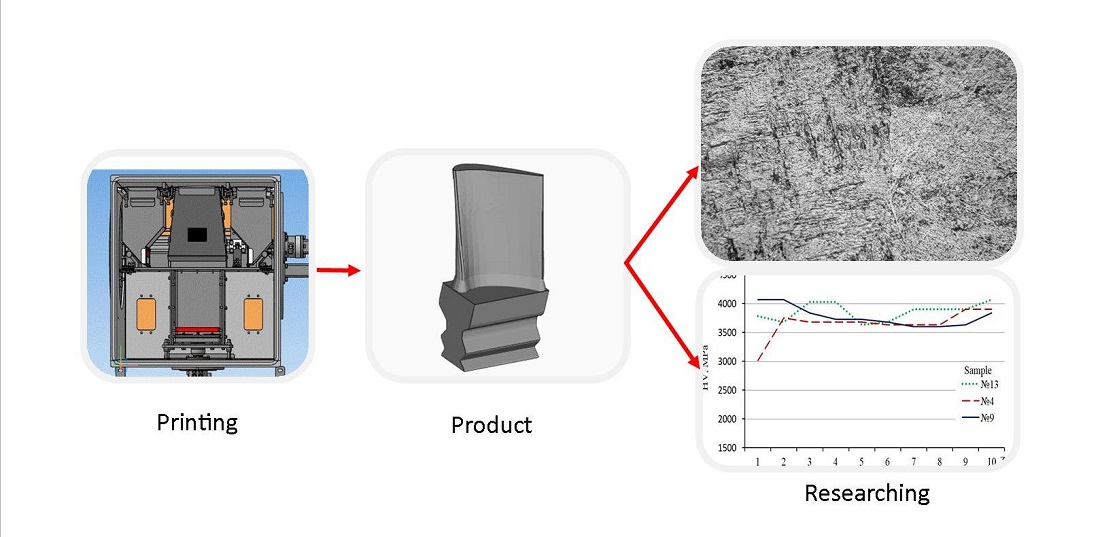Визначення впливу параметрів технологічного процесу електронно-променевого наплавлення на мікроструктуру і мікротвердість сплаву Ti-6Al-4V
DOI:
https://doi.org/10.15587/1729-4061.2024.297773Ключові слова:
електронно-променеве наплавлення, титановий сплав, Ti-6Al-4V, технологічні параметри, металографічні дослідженняАнотація
Представлено розроблену технологію та обладнання для виготовлення методами 3D друку деталей і вузлів із заздалегідь прогнозованими властивостями. В основі технології лежить застосування пучка електронів високої потужності для сплавлення металевого порошку у вакуумній камері з утворенням послідовних шарів, які повторюють контури цифрової моделі виробу.
Об’єктом досліджень є процес наплавлення виробів з порошку титанового сплаву Ti6Al4V. Досліджено вплив технологічних параметрів (швидкості та потужності електронного променя) на формування структури наплавленого металу та його механічні властивості.
Досліджено 3 зразки, які надруковані на 3 режимах: швидкість променя 270, 540 та 780 мм/с з потужністю 240, 495 та 675 Вт відповідно. Густина енергії променя 44,5 Дж/мм3, крок зміщення траєкторії 0,2 мм, струм динамічного фокусування Idf: –0,31 А, товщина шару порошку 0,1 мм були незмінні.
Зразки досліджували традиційними методами. Структури вивчали із застосуванням оптичного мікроскопа, зображення фіксували фотокамерою. Твердість за Вікерсом вимірювали мікротвердомером у напрямку від технологічних опор до поверхні зразка, а також вздовж поверхні виробу та в шарах середньої частини зразка.
Встановлено, що вироби мають щільну литу структуру наплавленого металу. На всіх зразках за висотою формуються великі кристаліти з однорідною пластинчасто-голчастою структурою α´-фази з невеликою кількістю β-фази, переважно без дефектів при рівномірній мікротвердості як за висотою, так і вздовж поверхні.
Визначено, що режим наплавлення: швидкість променю 240 мм/с; потужність 270 Вт є найбільш раціональним для практичного застосування. На цьому режимі відбувається формування більш міцної структури при її подрібненні зменшенні ширини кристалітів в 1,55 та 1,17 разів у порівнянні з іншими режимами
Посилання
- Matviichuk, V. A., Nesterenkov, V. M., Berdnikova, O. M. (2022). Additive electron beam technology of manufacture of metal products from powder materials. Avtomatičeskaâ Svarka (Kiev), 2022 (2), 16–25. https://doi.org/10.37434/as2022.02.03
- Matviichuk, V., Nesterenkov, V., Berdnikova, O. (2022). Determining the influence of technological parameters of the electron-beam surfacing process on quality indicators. Eastern-European Journal of Enterprise Technologies, 1 (12 (115)), 21–30. https://doi.org/10.15587/1729-4061.2022.253473
- Wanjara, P., Backman, D., Sikan, F., Gholipour, J., Amos, R., Patnaik, P., Brochu, M. (2022). Microstructure and Mechanical Properties of Ti-6Al-4V Additively Manufactured by Electron Beam Melting with 3D Part Nesting and Powder Reuse Influences. Journal of Manufacturing and Materials Processing, 6 (1), 21. https://doi.org/10.3390/jmmp6010021
- Tan, X., Kok, Y., Tan, Y. J., Descoins, M., Mangelinck, D., Tor, S. B. et al. (2015). Graded microstructure and mechanical properties of additive manufactured Ti–6Al–4V via electron beam melting. Acta Materialia, 97, 1–16. https://doi.org/10.1016/j.actamat.2015.06.036
- Kok, Y., Tan, X., Tor, S. B., Chua, C. K. (2015). Fabrication and microstructural characterisation of additive manufactured Ti-6Al-4V parts by electron beam melting. Virtual and Physical Prototyping, 10 (1), 13–21. https://doi.org/10.1080/17452759.2015.1008643
- Kok, Y. H., Tan, X. P., Loh, N. H., Tor, S. B., Chua, C. K. (2016). Geometry dependence of microstructure and microhardness for selective electron beam-melted Ti–6Al–4V parts. Virtual and Physical Prototyping, 11 (3), 183–191. https://doi.org/10.1080/17452759.2016.1210483
- Ran, J., Jiang, F., Sun, X., Chen, Z., Tian, C., Zhao, H. (2020). Microstructure and Mechanical Properties of Ti-6Al-4V Fabricated by Electron Beam Melting. Crystals, 10 (11), 972. https://doi.org/10.3390/cryst10110972
- Wang, X., Chou, K. (2018). EBSD study of beam speed effects on Ti-6Al-4V alloy by powder bed electron beam additive manufacturing. Journal of Alloys and Compounds, 748, 236–244. https://doi.org/10.1016/j.jallcom.2018.03.173
- Sino-Euro Materials Technologies. Available at: https://en.c-semt.com/ti/
- Grabin, V. F. (1975). Osnovy metallovedeniya i termicheskoy obrabotki svarnyh soedineniy iz titanovyh splavov. Kyiv: Naukova dumka, 263.
- Zamkov, V. N. (Ed.) (1986). Metallurgiya i tehnologiya svarki titana i ego splavov. Kyiv: Naukova dumka, 240.

##submission.downloads##
Опубліковано
Як цитувати
Номер
Розділ
Ліцензія
Авторське право (c) 2024 Vladyslav Matviichuk, Vladimir Nesterenkov, Olena Berdnikova

Ця робота ліцензується відповідно до Creative Commons Attribution 4.0 International License.
Закріплення та умови передачі авторських прав (ідентифікація авторства) здійснюється у Ліцензійному договорі. Зокрема, автори залишають за собою право на авторство свого рукопису та передають журналу право першої публікації цієї роботи на умовах ліцензії Creative Commons CC BY. При цьому вони мають право укладати самостійно додаткові угоди, що стосуються неексклюзивного поширення роботи у тому вигляді, в якому вона була опублікована цим журналом, але за умови збереження посилання на першу публікацію статті в цьому журналі.
Ліцензійний договір – це документ, в якому автор гарантує, що володіє усіма авторськими правами на твір (рукопис, статтю, тощо).
Автори, підписуючи Ліцензійний договір з ПП «ТЕХНОЛОГІЧНИЙ ЦЕНТР», мають усі права на подальше використання свого твору за умови посилання на наше видання, в якому твір опублікований. Відповідно до умов Ліцензійного договору, Видавець ПП «ТЕХНОЛОГІЧНИЙ ЦЕНТР» не забирає ваші авторські права та отримує від авторів дозвіл на використання та розповсюдження публікації через світові наукові ресурси (власні електронні ресурси, наукометричні бази даних, репозитарії, бібліотеки тощо).
За відсутності підписаного Ліцензійного договору або за відсутністю вказаних в цьому договорі ідентифікаторів, що дають змогу ідентифікувати особу автора, редакція не має права працювати з рукописом.
Важливо пам’ятати, що існує і інший тип угоди між авторами та видавцями – коли авторські права передаються від авторів до видавця. В такому разі автори втрачають права власності на свій твір та не можуть його використовувати в будь-який спосіб.










